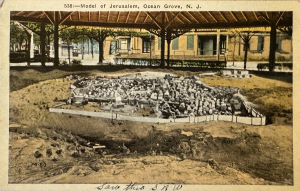The cover of the City of Tel Aviv’s 1939 Year Book depicts the newly constructed port, which was officially opened in 1938. The Tel Aviv port was built in response to the general strike of Arab workers at the Jaffa port in 1936-1939, so the Jewish community would cease being dependent on non-Jewish labour. Workers from Thessaloniki who came to Tel Aviv from Haifa, were hired, and built the new port’s jetty in one night.
The port had been operational for only two years when it was taken over by the British Navy during the Second World War. Prior to Israel’s independence in May 1948, a substantial amount of military equipment was smuggled into the country through this facility. The port was then only partially operational until 1965, when its operations were moved to Ashdod. The area declined and was a low-cost shopping area until it started to be revitalized early in this century, and it became the Namal, a popular tourist, dining and recreational area.
The name Tel Aviv is the Hebrew translation of Altneuland (Old New Land), written by Theodor Herzl in 1902, seven years before the city was established. Tel is an archaeological term for a mound with the debris of a succession of settlements (something old) while aviv means spring (or something new or renewal). Altneuland was translated by Nahum Sokolov who adopted the title from the reference to Tel Aviv (an unidentified city in what is now Iraq) in Ezekiel 3:15.
The book of Ezekiel also includes in Chapter 37 the prophesy of the dry bones. Ezekiel was taken to a valley that was full of dry bones and he witnessed how they were brought back to life again. When the bones were reattached to form skeletons (which represent the people of Israel) they said “our hope is lost”.
Israel’s national anthem, Hatikvah, responds to that vision when it says od lo avda tikavatenu (our hope is not yet lost). Tel Aviv today is a testament to that spirit. Numerous residential buildings are under construction, a light rail system is being built and the restaurants are full.
Hatikvah means the hope. A walk through Tel Aviv reminds you that despite what Israel has experienced in the last 16 months, hope is not lost, and it will never be.







